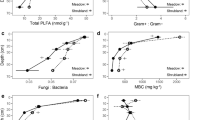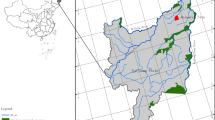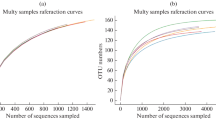Abstract
Arctic ecosystems are under pressure from climate change and atmospheric nitrogen (N) deposition. However, knowledge of the ecology of microbial communities and their responses to such challenges in Arctic tundra soil remain limited, despite the central role these organisms play for ecosystem functioning. We utilised a plot-scale experiment in High Arctic tundra on Svalbard to investigate short-term variation (9 days), following simulation of a N deposition event (4 kg N ha−1 yr−1), in the structure and abundance of bacterial, archaeal and fungal communities between organic and mineral soil horizons. T-RFLP analysis showed significant differences between horizons in bacterial and archaeal community structure. Q-PCR analysis showed that fungal abundance did not differ significantly between soil horizons, whilst bacterial and archaeal abundance was significantly higher in mineral than in organic horizons, despite soil water and total C and N contents being significantly greater in the organic horizon. In the organic horizon, bacterial community structure and fungal abundance varied significantly over time. In the mineral horizon, there was significant variation over time in bacterial abundance, in archaeal community structure and in both fungal community structure and abundance. In contrast, N deposition did not lead to significant variation in either the structure or the abundance of microbial communities. This research demonstrates that microbial community structure and abundance can change rapidly (over only a few days) in Arctic tundra soils and also differently between soil horizons in response to different environmental drivers. Moreover, this variability in microbial community structure and abundance is soil horizon- and taxonomic domain-specific, highlighting the importance of investigating microbial communities across all soil horizons and over short periods of time.





Similar content being viewed by others
References
Anisimov O, Fitzharris B (2001) Polar regions (Arctic and Antarctic). In: McCarthy JJ, Canziani OF, Leary NA, Dokken DJ, White KS (eds) Intergovernmental panel on climate change 2001: impacts, adaptation, and vulnerability. Cambridge University Press, Cambridge, pp 801–841
Chapin FS, Shaver GR, Giblin AE et al (1995) Responses of Arctic tundra to experimental and observed changes in climate. Ecology 76:694–711
Chu H, Fierer N, Lauber CL, Caporaso JG, Knight R, Grogan P (2010) Soil bacterial diversity in the Arctic is not fundamentally different from that found in other biomes. Environ Microbiol 12:2998–3006
Chu H, Neufeld JD, Walker VK, Grogan P (2011) The influence of vegetation type on the dominant soil bacteria, archaea, and fungi in a Low Arctic tundra landscape. Soil Sci Soc Am J 75:1756
Clarke KR, Ainsworth M (1993) A method of linking multivariate community structure to environmental variables. Mar Ecol Prog Ser 92:205–219
Clarke KR, Gorley RN (2006) User manual/tutorial. PRIMER-E, Plymouth
Clarke KR, Green RH (1988) Statistical design and analysis for a “biological effects” study. Mar Ecol Prog Ser 46:213–226
Clarke KR, Somerfield PJ, Chapman MG (2006) On resemblance measures for ecological studies, including taxonomic dissimilarities and a zero-adjusted Bray–Curtis coefficient for denuded assemblages. J Exp Mar Biol Ecol 330:55–80
DeLong EF (1992) Archaea in coastal marine environments. Proc Natl Acad Sci USA 89:5685–5689
Deslippe JR, Egger KN, Henry GHR (2005) Impacts of warming and fertilization on nitrogen-fixing microbial communities in the Canadian high Arctic. FEMS Microbiol Ecol 53:41–50
Deslippe JR, Hartmann M, Mohn WW, Simard SW (2011) Long-term experimental manipulation of climate alters the ectomycorrhizal community of Betula nana in Arctic tundra. Glob Change Biol 17:1625–1636
Deslippe JR, Hartmann M, Simard SW, Mohn WW (2012) Long-term warming alters the composition of Arctic soil microbial communities. FEMS Microbiol Ecol 82:303–315
Engel K, Pinnell L, Cheng J, Charles TC, Neufeld JD (2012) Nonlinear electrophoresis for purification of soil DNA for metagenomics. J Microbiol Methods 88:35–40
Etcheverría P, Huygens D, Godoy R, Borie F, Boeckx P (2009) Arbuscular mycorrhizal fungi contribute to 13C and 15 N enrichment of soil organic matter in forest soils. Soil Biol Biochem 41:858–861
Fierer N, Jackson B (2006) The diversity and biogeography of soil bacterial communities. Proc Natl Acad Sci USA 103:626–631
Fierer N, Schimel JP, Holden PA (2003) Variations in microbial community composition through two soil depth profiles. Soil Biol Biochem 35:167–176
Fujimura KE, Egger KN, Henry GHR (2007) The effect of experimental warming on the root-associated fungal community of Salix arctica. ISME J 2:105–114
Gardes M, Bruns TD (1993) ITS primers with enhanced specificity for basidiomycetes—application to the identification of mycorrhizae and rusts. Mol Ecol 2:113–118
Geml J, Timling I, Robinson CH, Nusbaum HC, Brochmann C, Noordeloos M, Taylor DL (2012) An arctic community of symbiotic fungi assembled by long-distance dispersers: phylogenetic diversity of ectomycorrhizal basidiomycetes in Svalbard based on soil and sporocarp DNA. J Biogeogr 39:74–88
Girvan MS, Bullimore J, Pretty JN, Osborn AM, Ball AS (2003) Soil type is the primary determinant of the composition of the total and active bacterial communities in arable soils. Appl Environ Microbiol 69:1800–1809
Gordon C, Wynn JM, Woodin SJ (2001) Impacts of increased nitrogen supply on high Arctic heath: the importance of bryophytes and phosphorus availability. New Phytol 149:461–471
Hodson AJ, Mumford PN, Kohler J, Wynn PM (2005) The high Arctic glacial ecosystem: new insights from nutrient budgets. Biogeochemistry 72:233–256
Hodson AJ, Roberts TJ, Engvall A-C et al (2010) Glacier ecosystem response to episodic nitrogen enrichment in Svalbard, European high Arctic. Biogeochemistry 98:171–184
Høj L, Olsen RA, Torsvik VL (2005) Archaeal communities in high Arctic wetlands at Spitsbergen, Norway (78°N) as characterized by 16S rRNA gene fingerprinting. FEMS Microbiol Ecol 53:89–101
Høj L, Rusten M, Haugen LE, Olsen RA, Torsvik VL (2006) Effects of water regime on archaeal community composition in Arctic soils. Environ Microbiol 8:984–996
Høj L, Olsen RA, Torsvik VL (2008) Effects of temperature on the diversity and community structure of known methanogenic groups and other archaea in high Arctic peat. ISME J 2:37–48
IPCC (2007) Contribution of working groups I, II and III to the fourth assessment report of the intergovernmental panel on climate change. Pachauri RK & Reisinger A, Geneva, Switzerland
Jefferies RL, Maron JL (1997) The embarrassment of riches: atmospheric deposition of nitrogen and community and ecosystem processes. Trends Ecol Evol 12:74–78
Kamphake LJ, Hannah SA, Cohen JM (1967) Automated analysis for nitrate by hydrazine reduction. Water Res 1:205–216
Krom MD (1980) Spectrophotometric determination of ammonia: a study of a modified Berthelot reaction using salicylate and dichloroisocyanurate. Analyst 105:305–316
Kühnel R, Roberts TJ, Björkman MP, Isaksson E, Aas W, Holmén K, Ström J (2011) 20-Year climatology of NO3 − and NH4 + wet deposition at Ny-Ålesund, Svalbard. Adv Meteorol 2011:1–10
Lamb EG, Han S, Lanoil BD, Henry GR, Brumell ME, Banerjee S, Siciliano SD (2011) A high Arctic soil ecosystem resists long-term environmental manipulations. Glob Change Biol 17:3187–3194
Landeweert R, Leeflang P, Kuyper TW, Hoffland E, Rosling A, Wernars K, Smit E (2003) Molecular identification of ectomycorrhizal mycelium in soil horizons. Appl Environ Microbiol 69:327–333
Lane D (1991) 16S/23S rRNA sequencing. Nucleic acid techniques in bacterial systematics. Willey, New York, pp 115–175
Lauber CL, Hamady M, Knight R, Fierer N (2009) Pyrosequencing-based assessment of soil pH as a predictor of soil bacterial community structure at the continental scale. Appl Environ Microbiol 75:5111–5120
Lee S-H, Jang I, Chae N, Choi T, Kang H (2013) Organic layer serves as a hotspot of microbial activity and abundance in Arctic tundra soils. Microb Ecol 65:405–414
Lueders T, Friedrich MW (2003) Evaluation of PCR amplification bias by terminal restriction fragment length polymorphism analysis of small-subunit rRNA and mcrA genes by using defined template mixtures of methanogenic pure cultures and soil DNA Extracts. Appl Environ Microbiol 69:320–326
Männistö MK, Tiirola M, Häggblom MM (2007) Bacterial communities in Arctic fjelds of Finnish Lapland are stable but highly pH-dependent. FEMS Microbiol Ecol 59:452–465
Manter DK, Vivanco JM (2007) Use of the ITS primers, ITS1F and ITS4, to characterize fungal abundance and diversity in mixed-template samples by qPCR and length heterogeneity analysis. J Microbiol Methods 71:7–14
Marchesi JR, Sato T, Weightman AJ, Martin TA, Fry JC, Hiom SJ, Wade WG (1998) Design and evaluation of useful bacterium-specific PCR primers that amplify genes coding for bacterial 16S rRNA. Appl Environ Microbiol 64:795–799
McMahon SK, Wallenstein MD, Schimel JP (2011) A cross-seasonal comparison of active and total bacterial community composition in Arctic tundra soil using bromodeoxyuridine labeling. Soil Biol Biochem 43:287–295
Muyzer G, de Waal EC, Uitterlinden AG (1993) Profiling of complex microbial populations by denaturing gradient gel electrophoresis analysis of polymerase chain reaction-amplified genes coding for 16S rRNA. Appl Environ Microbiol 59:695–700
Nemergut DR, Costello EK, Meyer AF, Pescador MY, Weintraub MN, Schmidt SK (2005) Structure and function of alpine and arctic soil microbial communities. Res Microbiol 156:775–784
Neufeld JD, Mohn WW (2005) Unexpectedly high bacterial diversity in Arctic tundra relative to boreal forest soils, revealed by serial analysis of ribosomal sequence tags. Appl Environ Microbiol 71:5710–5718
Ning J, Liebich J, Kästner M, Zhou J, Schäffer A, Burauel P (2009) Different influences of DNA purity indices and quantity on PCR-based DGGE and functional gene microarray in soil microbial community study. Appl Microbiol Biotechnol 82:983–993
Nordin A, Schmidt IK, Shaver GR (2004) Nitrogen uptake by Arctic soil microbes and plants in relation to soil nitrogen supply. Ecology 85:955–962
Osborn AM, Moore ERB, Timmis KN (2000) An evaluation of terminal-restriction fragment length polymorphism (T-RFLP) analysis for the study of microbial community structure and dynamics. Environ Microbiol 2:39–50
Øvreas L, Forney L, Daae FL, Torsvik V (1997) Distribution of bacterioplankton in meromictic Lake Saelenvannet, as determined by denaturing gradient gel electrophoresis of PCR-amplified gene fragments coding for 16S rRNA. Appl Environ Microbiol 63:3367–3373
R Development Core Team (2014) R: a language and environment for statistical computing. Vienna, Austria: the R foundation for statistical computing. Available online at http://www.R-project.org/
Reysenbach A-L, Pace NR (1995) Reliable amplification of hyperthermophilic archaeal 16S rRNA genes by the polymerase chain reaction. Archaea: a laboratory manual. CSHL Press, New York, pp 101–105
Rinnan R, Michelsen A, Bååth E, Jonasson S (2007) Fifteen years of climate change manipulations alter soil microbial communities in a subarctic heath ecosystem. Glob Change Biol 13:28–39
Ririe KM, Rasmussen RP, Wittwer CT (1997) Product differentiation by analysis of DNA melting curves during the polymerase chain reaction. Anal Biochem 245:154–160
Robinson CH, Wookey PA, Parsons AN, Potter JA, Callaghan TV, Lee JA, Press MC, Welker JM (1995) Responses of plant litter decomposition and nitrogen mineralisation to simulated environmental change in a high arctic polar semi-desert and a subarctic dwarf shrub heath. Oikos 74:503–512
Robinson CH, Saunders PW, Madan NJ, Pryce-Miller EJ, Pentecost A (2004) Does nitrogen deposition affect soil microfungal diversity and soil N and P dynamics in a high Arctic ecosystem? Glob Change Biol 10:1065–1079
Schmidt IK, Ruess L, Bååth E et al (2000) Long-term manipulation of the microbes and microfauna of two subarctic heaths by addition of fungicide, bactericide, carbon and fertilizer. Soil Biol Biochem 32:707–720
Shaver GR, Chapin FS (1980) Response to fertilization by various plant growth forms in an Alaskan tundra: nutrient accumulation and growth. Ecology 61:662
Smith CJ, Danilowicz BS, Clear AK, Costello FJ, Wilson B, Meijer WG (2005) T-Align, a web-based tool for comparison of multiple terminal restriction fragment length polymorphism profiles. FEMS Microbiol Ecol 54:375–380
Smith CJ, Nedwell DB, Dong LF, Osborn AM (2006) Evaluation of quantitative polymerase chain reaction-based approaches for determining gene copy and gene transcript numbers in environmental samples. Environ Microbiol 8:804–815
Stapleton LM, Crout NMJ, Säwström C, Marshall WA, Poulton PR, Tye AM, Laybourn-Parry J (2005) Microbial carbon dynamics in nitrogen amended Arctic tundra soil: measurement and model testing. Soil Biol Biochem 37:2088–2098
Tye AM, Young SD, Crout NMJ, West HM, Stapleton LM, Poulton PR, Laybourn-Parry J (2005) The fate of 15N added to High Arctic tundra to mimic increased inputs of atmospheric nitrogen released from a melting snowpack. Glob Change Biol 11:1640–1654
Van Wijk MT, Clemmensen KE, Shaver GR, Williams M, Callaghan TV, Chapin FS, Cornelissen JHC, Gough L, Hobbie SE, Jonasson S (2004) Long-term ecosystem level experiments at Toolik Lake, Alaska, and at Abisko, Northern Sweden: generalizations and differences in ecosystem and plant type responses to global change. Glob Change Biol 10:105–123
Vilgalys R, Hester M (1990) Rapid genetic identification and mapping of enzymatically amplified ribosomal DNA from several Cryptococcus species. J Bacteriol 172:4238–4246
Walker JKM, Egger KN, Henry GHR (2008) Long-term experimental warming alters nitrogen-cycling communities but site factors remain the primary drivers of community structure in high arctic tundra soils. ISME J 2:982–995
Wallenstein MW, McMahon S, Schimel J (2007) Bacterial and fungal community structure in Arctic tundra tussock and shrub soils. FEMS Microbiol Ecol 59:428–435
White TJ, Bruns TD, Lee S, Taylor J (1990) Amplification and direct sequencing of fungal ribosomal RNA genes for phylogenetics. In: Innis MA, Gelfand DH, Shinsky JJ, White TJ (eds) PCR protocols: a guide to methods and application. Academic Press, New York, pp 315–322
Zhou J, Xia B, Treves DS et al (2002) Spatial and resource factors influencing high microbial diversity in soil. Appl Environ Microbiol 68:326–334
Acknowledgments
This work was funded by a European Union Marie Curie Initial Stage Training Network award NSINK (FP7 215503) to AMO and GKP. The authors thank the Natural Environment Research Council (NERC) for access to and use of their Arctic Research station in Ny-Ålesund. We would like to thank Mr. Nick Cox, manager of the NERC Arctic research station, for his help and support throughout the fieldwork, Aga Nowak-Zwierz for help during the fieldwork and Sonal Choudhary and Heather Walker for assistance with total C and N analysis.
Author information
Authors and Affiliations
Corresponding author
Electronic supplementary material
Below is the link to the electronic supplementary material.
Rights and permissions
About this article
Cite this article
Blaud, A., Phoenix, G.K. & Osborn, A.M. Variation in bacterial, archaeal and fungal community structure and abundance in High Arctic tundra soil. Polar Biol 38, 1009–1024 (2015). https://doi.org/10.1007/s00300-015-1661-8
Received:
Revised:
Accepted:
Published:
Issue Date:
DOI: https://doi.org/10.1007/s00300-015-1661-8




